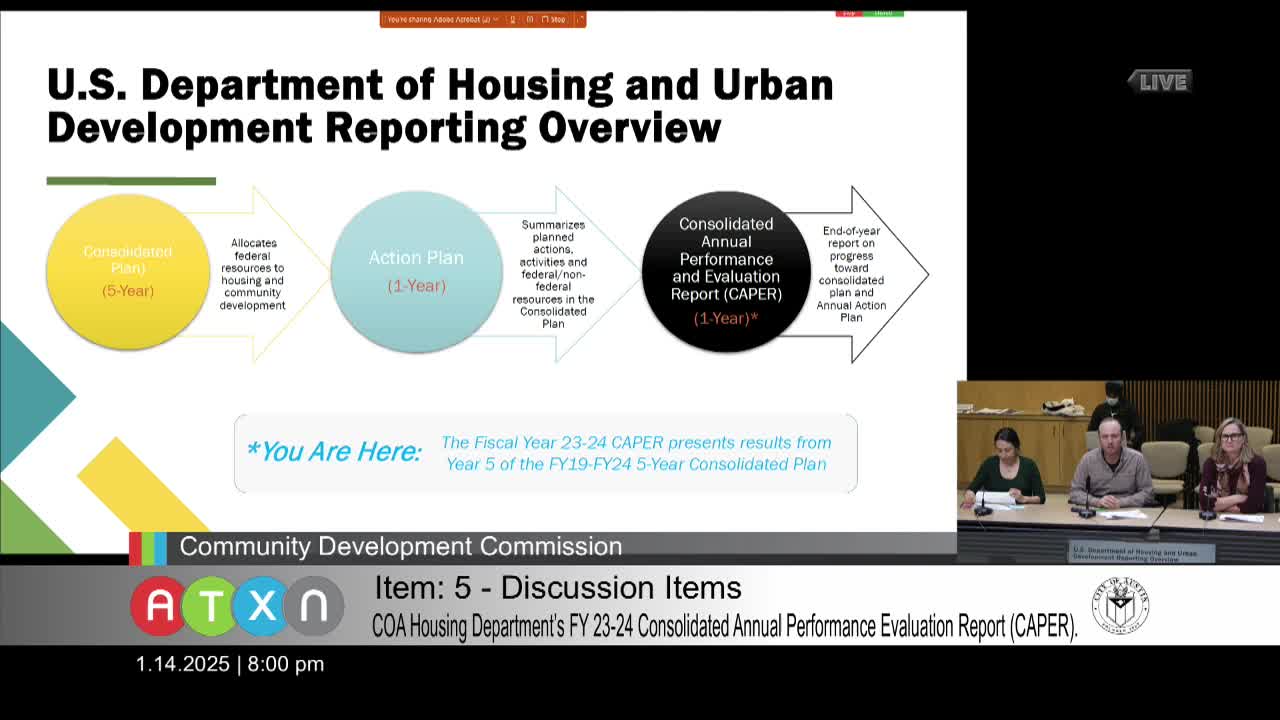Housing department reviews FY22–23 CAPER results, HUD grants and upcoming action‑plan timeline
January 14, 2025 | Austin, Travis County, Texas
This article was created by AI summarizing key points discussed. AI makes mistakes, so for full details and context, please refer to the video of the full meeting. Please report any errors so we can fix them. Report an error »

Rocio Pena Martinez, the Housing Department’s grants program manager, and finance staff presented the department’s CAPER — the Consolidated Annual Performance and Evaluation Report — and walked commissioners through how the consolidated plan, annual action plan and CAPER fit together.
Pena Martinez described the federal planning and reporting cycle: the consolidated plan sets five‑year investment categories; each year the department produces an action plan that budgets anticipated federal funds; and the CAPER reports results back to HUD for the prior action‑plan year. Chase Clemons, financial manager, and Interim Director Mandy DeMaio provided program highlights and answered commissioners’ questions.
Staff summarized FY22–23 action plan results across program categories. As an example of the type of variance the CAPER documents, Clemons pointed to a category where the department budgeted $3,480,745 for a set of activities, estimated serving 970 people or units, and reported actual results of $2,210,185 expended serving 817. Clemons and Pena Martinez said variances occur for many reasons: timing of construction, multi‑year projects, project draws, and the federal reporting cadence.
Staff reviewed specific program results and operating notes: the HOME program and down‑payment assistance served 29 households in the past year with assistance levels up to $40,000; minor home repair and homeowner rehabilitation programs continue; tenant‑landlord mediation (previously contracted with Austin Tenants Council) now sits with Texas Rio Grande Legal Aid after organizational changes; and the city uses a variety of federal and local funds to support housing, including general‑obligation (GO) bond proceeds allocated in voter‑approved measures. DeMaio summarized prior GO bond authorizations: 2006 ($55 million), 2013 ($65 million), 2018 ($250 million) and 2022 ($350 million) and noted the department is implementing a multi‑year spend plan for bond proceeds.
Commissioners asked for clarity about tenant rights and eviction legal assistance; Nephertiti Jackman, community displacement prevention officer, explained that the tenant‑landlord contract funds mediation and that other eviction prevention legal services are administered separately with different funding sources. Commissioners also discussed program timelines, HUD spending/timeliness ratios, and the department’s plan to provide a clear calendar of planning, budget and reporting deadlines — staff committed to present a calendar and timeline at the commission’s next meeting.
Ending: Housing staff said they will return with a clear, shareable calendar of consolidated‑plan / action‑plan / CAPER milestones and noted that the upcoming FY2025–26 action‑plan process will begin in spring with public engagement and an adoption target in summer for an Oct. 1 start of the fiscal year.
Pena Martinez described the federal planning and reporting cycle: the consolidated plan sets five‑year investment categories; each year the department produces an action plan that budgets anticipated federal funds; and the CAPER reports results back to HUD for the prior action‑plan year. Chase Clemons, financial manager, and Interim Director Mandy DeMaio provided program highlights and answered commissioners’ questions.
Staff summarized FY22–23 action plan results across program categories. As an example of the type of variance the CAPER documents, Clemons pointed to a category where the department budgeted $3,480,745 for a set of activities, estimated serving 970 people or units, and reported actual results of $2,210,185 expended serving 817. Clemons and Pena Martinez said variances occur for many reasons: timing of construction, multi‑year projects, project draws, and the federal reporting cadence.
Staff reviewed specific program results and operating notes: the HOME program and down‑payment assistance served 29 households in the past year with assistance levels up to $40,000; minor home repair and homeowner rehabilitation programs continue; tenant‑landlord mediation (previously contracted with Austin Tenants Council) now sits with Texas Rio Grande Legal Aid after organizational changes; and the city uses a variety of federal and local funds to support housing, including general‑obligation (GO) bond proceeds allocated in voter‑approved measures. DeMaio summarized prior GO bond authorizations: 2006 ($55 million), 2013 ($65 million), 2018 ($250 million) and 2022 ($350 million) and noted the department is implementing a multi‑year spend plan for bond proceeds.
Commissioners asked for clarity about tenant rights and eviction legal assistance; Nephertiti Jackman, community displacement prevention officer, explained that the tenant‑landlord contract funds mediation and that other eviction prevention legal services are administered separately with different funding sources. Commissioners also discussed program timelines, HUD spending/timeliness ratios, and the department’s plan to provide a clear calendar of planning, budget and reporting deadlines — staff committed to present a calendar and timeline at the commission’s next meeting.
Ending: Housing staff said they will return with a clear, shareable calendar of consolidated‑plan / action‑plan / CAPER milestones and noted that the upcoming FY2025–26 action‑plan process will begin in spring with public engagement and an adoption target in summer for an Oct. 1 start of the fiscal year.
View full meeting
This article is based on a recent meeting—watch the full video and explore the complete transcript for deeper insights into the discussion.
View full meeting
